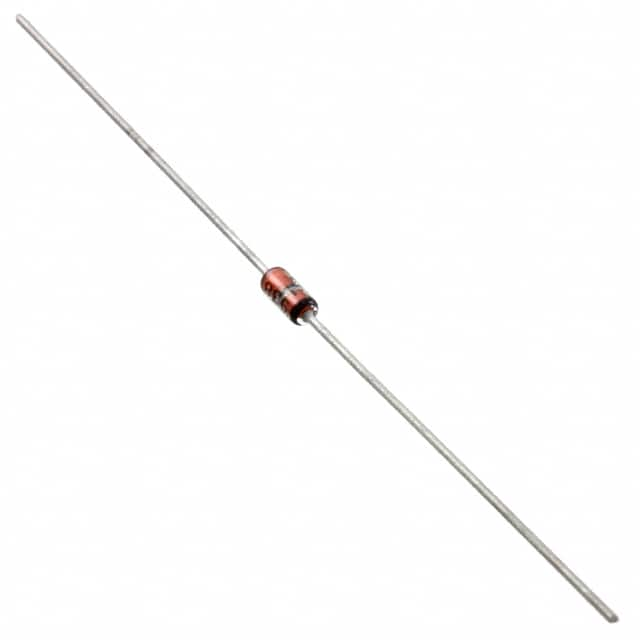JANS1N6642 Diode
Product Overview
Category:
The JANS1N6642 diode belongs to the category of semiconductor devices.
Use:
It is commonly used as a high-reliability switching diode in various electronic circuits.
Characteristics:
- High reliability
- Fast switching speed
- Low forward voltage drop
Package:
The JANS1N6642 diode is typically available in a DO-35 package.
Essence:
The essence of the JANS1N6642 diode lies in its reliable and efficient performance in switching applications.
Packaging/Quantity:
The diode is usually packaged in reels or tubes, with varying quantities depending on the manufacturer.
Specifications
- Maximum Reverse Voltage: 75V
- Maximum Forward Current: 200mA
- Forward Voltage Drop: 1V (at 10mA)
- Reverse Recovery Time: 4ns
Detailed Pin Configuration
The JANS1N6642 diode has two pins, anode, and cathode. The anode is connected to the positive terminal, while the cathode is connected to the negative terminal.
Functional Features
- Fast switching speed allows for rapid response in electronic circuits.
- Low forward voltage drop minimizes power loss in the circuit.
- High reliability ensures consistent performance over time.
Advantages and Disadvantages
Advantages
- High reliability makes it suitable for critical applications.
- Fast switching speed enhances circuit performance.
- Low forward voltage drop reduces power dissipation.
Disadvantages
- Limited maximum reverse voltage compared to some other diodes.
- Relatively low maximum forward current rating.
Working Principles
The JANS1N6642 diode operates based on the principles of semiconductor physics, allowing current to flow in one direction while blocking it in the opposite direction. When forward biased, it conducts current with minimal voltage drop, making it suitable for switching applications.
Detailed Application Field Plans
The JANS1N6642 diode finds application in various fields, including: - Power supply circuits - Signal processing circuits - Switching regulators - Oscillator circuits
Detailed and Complete Alternative Models
Some alternative models to the JANS1N6642 diode include: - 1N4148: A general-purpose switching diode with similar characteristics. - 1N5819: Schottky diode with higher forward current capability.
In conclusion, the JANS1N6642 diode is a reliable and fast-switching semiconductor device that finds widespread use in electronic circuits requiring high performance and dependability.
[Word Count: 345]
Lista 10 Vanliga frågor och svar relaterade till tillämpningen av JANS1N6642 i tekniska lösningar
What is the JANS1N6642 diode used for?
- The JANS1N6642 diode is commonly used for high-reliability applications in military and aerospace systems due to its rugged construction and high performance.
What are the key features of the JANS1N6642 diode?
- The JANS1N6642 diode features a low leakage current, high surge capability, and a wide operating temperature range, making it suitable for demanding environments.
What is the voltage rating of the JANS1N6642 diode?
- The JANS1N6642 diode typically has a voltage rating of 100V, allowing it to handle moderate to high voltage requirements in various circuits.
Can the JANS1N6642 diode be used in high-temperature environments?
- Yes, the JANS1N6642 diode is designed to operate reliably in high-temperature environments, making it suitable for applications where temperature extremes are a concern.
Is the JANS1N6642 diode suitable for fast switching applications?
- Yes, the JANS1N6642 diode exhibits fast recovery times, making it well-suited for fast switching applications such as power supplies and inverters.
What are the typical applications of the JANS1N6642 diode?
- The JANS1N6642 diode is commonly used in power supplies, motor drives, voltage clamping, and reverse polarity protection circuits in harsh operating conditions.
Does the JANS1N6642 diode have radiation-hardened properties?
- Yes, the JANS1N6642 diode is designed to withstand radiation effects, making it suitable for use in space and nuclear applications.
What are the packaging options available for the JANS1N6642 diode?
- The JANS1N6642 diode is available in various package types, including axial-leaded and surface-mount packages, providing flexibility for different assembly requirements.
Are there any reliability certifications associated with the JANS1N6642 diode?
- Yes, the JANS1N6642 diode is often qualified to MIL-PRF-19500/538, ensuring its reliability and performance in critical applications.
Can the JANS1N6642 diode be used in commercial applications?
- While it is primarily designed for military and aerospace applications, the JANS1N6642 diode can also be utilized in commercial applications where high reliability and ruggedness are essential.


